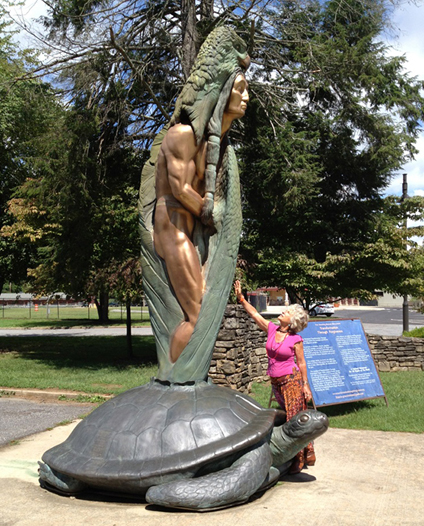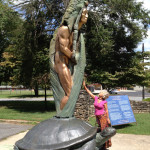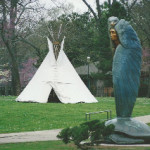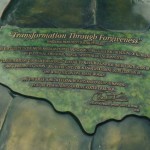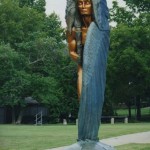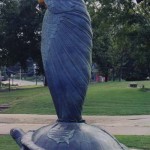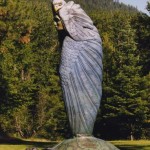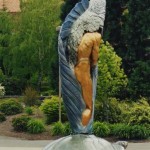The Monument to Forgiveness was donated to Northeastern State University in Tahlequah, OK, which is at the end of the Trail of Tears.
Dedicated to Earth
Awareness and Stewardship
This monument brings awareness
of human interdependence
on the Earth’s environment,
not only for our own sustenance and survival,
but also for that of all life forms.
Our relationship with the earth is a partnership,
requiring our respect, honor and active stewardship.
In return, we receive its miraculous life support systems and resources.
We are called to recognize that we need to restore balance
in our relationship with the Earth and each other,
and so to act, that future generations may survive and thrive.
~ Francis Jansen.
The Monument to Forgiveness uniquely honors the essential contribution of all indigenous peoples. And now, as our contemporary world is woven of many cultural expressions, we are being called to embrace all expressions as part of a greater whole.
Our purpose, as we review our collective history, is to bring it into that greater wholeness; to acknowledge, to heal and to reconcile, where possible, the inhumanities of our past. We do this so that we can look with clarity and deeper humanity to our future, as we evolve toward our fullest potential as co-inhabitants of Mother Earth.
The creation of the monument began while sculptor Francis Jansen, a Dutch-born immigrant, was visiting a stone quarry in Carrera, Italy. She found herself strongly drawn to a large elongated block of marble. While gazing at the stone, it virtually opened to reveal the image of a Native American man lying with his face on the ground. As Francis began the sculpting process of releasing the vision, a being she lovingly refers to as Eagle Man, emerged from the marble.
This arduous and euphoric birthing process took exactly nine months. During this time Francis became increasingly aware of the greater significance and potential of her work. From out of her enormous sense of gratitude for this now-embodied vision, grew the inspiration for the non-profit project called Transformation Through Forgiveness. She realized that the monument was, and is, a symbol and anchor for a far-reaching global movement of forgiveness and reconciliation.
This monument stood across the street from the Santa Barbara Mission, near the ruins of the Mission grist mill and the Rose Gardens from May 1993 till April 1995.
The monument became a popular local attraction, with flowers, eagle feathers, Native American Sun-dance ribbons, forgiveness-letters, fruit, and many other gratitude objects, left daily around the base in acknowledge of the purpose and meaning for reconciliation and forgiveness that the “Forgiveness” monument held for the populace.
Many ceremonies were held at the “Forgiveness” monument, including weddings, drum and prayer circles, and many other events and gatherings.
The Traveling Bronze Forgiveness Monument, a 14-foot tall replica with a large Turtle for its base was created and is touring our nation petitioning Forgiveness for our for-fathers, and then all of our fathers.
The Monument to Forgiveness has reverently and prayerfully traveled to:
- Santa Barbara Mission – Santa Barbara, California
- Nez Perce Indian hunting grounds – Wallowa Lake, Joseph, Oregon
- Southern Oregon University – Ashland, Oregon
- End of the Trail of Tears – Northeastern State University in Tahlequah Oklahoma
- The beginning of the Trail of Tears – Cherokee, North Carolina
On the concrete base on which the monument is placed.
Plaque 1:
The Monument was created by Dutch-born visionary sculptor Francis H. Jansen. It was gifted to Northeastern State University to honor Tahlequah as the End of the Trail of Tears. “To inspire, evoke and encourage in all humankind the spirit of reconciliation, transformation, and unity through forgiveness”.
Plaque 2:
This Monument is part of a Spirit-driven endeavor to bring awareness, and where possible, to help alleviate the imprint of suffering that has occurred at specific places stained by “man’s inhumanity to man”. It represents the sculptor Francis Jansen’s gesture of reconciliation on behalf of her European Ancestors to the First Peoples of this continent.
Plaque 3:
The Trail of Tears, called” Nunahi-Duna-Dio-Hilu-I” by the Cherokee for “Trail Where They Cried”, was a deeply tragic journey during which more than 100,000 Native Americans –- Creeks, Chickasaw, Choctaw, Seminole, and Cherokee—were forced from their native lands. Tahlequah is the site of one of the final destinations of this forced 1000-mile march.
Plaque 4:
Northeastern State University has graciously accepted stewardship of the Monument and provided “hallowed ground” where visitors may be inspired to acknowledge, contemplate and participate in ceremonies of reconciliation and forgiveness.
Plaque 5:
The Monument to Forgiveness stands as an invitation to all humankind to embrace healing through forgiveness so that we may join in unity to create a more peaceful, compassionate and sustainable future.
Forgiveness begins in the heart of each one of us — forgiveness of the Other being intimately entwined with forgiveness of Self.

